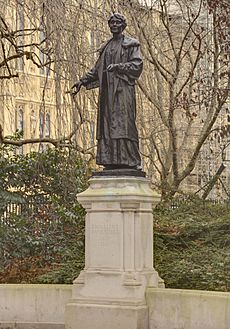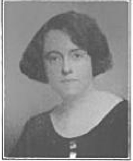Rachel Barrett facts for kids
Quick facts for kids
Rachel Barrett
|
|
|---|---|

Rachel Barrett
|
|
| Born | 12 November 1875 Carmarthen, Carmarthenshire, Wales
|
| Died | 26 August 1953 (aged 77) Faygate, Sussex, England
|
| Occupation | teacher political organiser editor |
Rachel Barrett (born November 12, 1874 – died August 26, 1953) was an important Welsh woman. She was a suffragette, which means she worked hard for women to get the right to vote. She also became a newspaper editor. Rachel was born in Carmarthen, Wales. She studied science at the University College of Wales and became a teacher. However, in 1906, she heard a speech about women's voting rights. This inspired her to join the Women's Social and Political Union (WSPU) and move to London.
In 1907, Rachel became an organizer for the WSPU. She helped lead the national campaign for women's votes. Later, she took charge of the WSPU's newspaper, The Suffragette, even though she had no experience in journalism. Rachel faced many challenges for her work. She sometimes had to hide to avoid being stopped by authorities.
Contents
Early Life and Education
Rachel Barrett was born in Carmarthen in 1874. Her parents were Rees Barrett and Anne Jones. Both of her parents spoke Welsh. She grew up in Llandeilo with her older brother, Rees, and younger sister, Janette. Her father passed away in 1878, so her mother raised the children.
Rachel went to a boarding school in Stroud. She was a bright student and won a scholarship to the University College of Wales, Aberystwyth. In 1904, she earned her science degree. After graduating, she worked as a science teacher in places like Llangefni, Carmarthen, and Penarth.
Fighting for Women's Rights
Joining the Suffrage Movement
In late 1906, Rachel attended a meeting in Cardiff about women's voting rights. She was very inspired by a speaker named Nellie Martel. Rachel felt strongly that fighting for women's votes was the right thing to do. She joined the Women's Social and Political Union (WSPU) right after the meeting.
By 1907, Rachel was very active with the WSPU. She helped organize meetings for Adela Pankhurst in Cardiff and Barry. Rachel often spoke at these meetings, sometimes in Welsh. Her school's headmistress did not like the attention Rachel was getting. This was especially true after Rachel was involved in a public incident at Cardiff Docks. In July 1907, Rachel decided to leave her teaching job. She enrolled at the London School of Economics to study economics. This school was close to the WSPU headquarters.
Rachel continued to be very busy with the WSPU. She campaigned in places like Bury St Edmunds and Bradford. She also influenced an American student named Alice Paul. Rachel was asked by Christabel Pankhurst to become a full-time organizer for the WSPU. She accepted this important role, even though it meant giving up her studies.
Organizing Campaigns
In 1908, Rachel organized campaigns in Nottingham, Dewsbury, and Dundee. She worked with other suffragette campaigners like Helen Fraser and Mary Gawthorpe. Rachel even chaired a platform at a large rally in Hyde Park. However, all this hard work made her unwell, and she had to take a break to recover.
After getting better, Rachel volunteered in Bristol. Soon, she agreed to become a paid organizer for the WSPU again. She was sent to Newport in south-east Wales. In 1910, Rachel was chosen to meet with David Lloyd George, a powerful politician. They talked about the Liberal Party's support for women's voting rights. After the meeting, Rachel believed he was not truly sincere. By the end of that year, Rachel was put in charge of all WSPU activities in Wales. She moved to the main office in Cardiff. Many people believe Rachel worked harder than anyone else to promote the campaign in Wales.
Editing The Suffragette Newspaper
In 1912, Rachel was chosen to help run the WSPU national campaign. This happened after police raided the WSPU office and Christabel Pankhurst went to Paris. Rachel moved back to London. Within a few months, she became the assistant editor of the WSPU's new newspaper, The Suffragette. The newspaper started in October 1912. Rachel later said that becoming an editor was "an appalling task" because she knew nothing about journalism.
Taking on this job also meant facing risks. The WSPU was becoming more active and sometimes used strong methods. Rachel secretly traveled to Paris to meet with Christabel Pankhurst. She even heard the sound of police listening in when she talked on the phone.
For the next two years, Rachel was key in keeping the newspaper going. This was difficult because the government tried to stop it. In April 1913, the newspaper's offices were raided by police. Staff members were taken in for questioning. Rachel was sentenced to nine months in Holloway Prison. She immediately went on a hunger strike, refusing to eat. She was then moved to Canterbury Prison. After five days, she was released under a special rule called the "Cat and Mouse Act". This law allowed hunger-striking prisoners to be released when they were very weak. They would then be re-arrested once they recovered.
Rachel moved to a safe house called "Mouse Castle." After three weeks, she was re-arrested. She went on hunger strike again and was released to "Mouse Castle" after four days. This time, she was secretly taken out of the house in a disguise. This allowed her to speak at meetings. She was re-arrested a second time and cared for by her friend I. A. R. Wylie. Rachel went on hunger strike a third time and was released. This time, she successfully avoided being caught. She went to a nursing home in Edinburgh and stayed there until December 1913.
After leaving Scotland, she secretly returned to London. She hid in a small room at Lincoln's Inn House. She could only get fresh air by going onto the roof. Rachel continued to edit The Suffragette. In May 1914, the newspaper's offices were raided again. Rachel traveled to Paris to talk about the newspaper's future with Christabel Pankhurst. They decided to move The Suffragette to Edinburgh. This way, the printers would be safer. Rachel moved to Edinburgh with Ida Wylie and used a different name, "Miss Ashworth." Rachel kept publishing the paper until its last edition. This was the week after the First World War began. During the war, Rachel supported Britain's military actions, like most of the suffragette movement.
After the Representation of the People Act 1918 was passed, some women in the United Kingdom could finally vote. Rachel continued to fight for all women to have full voting rights. When all women gained the right to vote in 1928, Rachel helped raise money for celebrations. She was also very important in raising funds for a statue of Emmeline Pankhurst. This statue is in Victoria Tower Gardens in London. Rachel understood that women's rights were important worldwide. She contacted campaigners in Canada and America for financial help. An article written after Rachel's death said that the statue was a lasting reminder of Rachel's great organizing skills. In 1929, Rachel became the secretary of the Equal Political Rights Campaign Committee. This group worked for equality between men and women in all areas of politics.
Later Life
In her later years, Rachel joined the Suffragette Fellowship. She was very close to Kitty Marshall, who lived nearby. Rachel tried to publish a book about Kitty Marshall in the late 1940s, but it was not published. In the early 1930s, Rachel moved to Sible Hedingham in Essex. She joined the Sible Hedingham Women's Institute in 1934 and remained a member until 1948. She lived in a home called Lamb Cottage.
Friendship with I. A. R. Wylie
While Rachel was editing The Suffragette, she became good friends with an Australian writer named I. A. R. Wylie. Ida Wylie wrote for the newspaper in 1913. In 1919, Rachel and Ida traveled to the United States. They bought a car and spent over a year traveling across the country. They stayed in New York and San Francisco. In the 1920 census, they were recorded living in Carmel-By-The-Sea, California. Ida was listed as the head of the household, and Rachel as her friend.
The two women remained close for a long time. In 1928, they supported their friends Una Troubridge and Radclyffe Hall during a famous court case. When Rachel Barrett passed away, she left most of her belongings to Ida Wylie.
Death
Rachel Barrett passed away on August 26, 1953. She was 78 years old. She died at the Carylls Nursing Home in Faygate, Sussex. She left Lamb Cottage to her niece, Gwyneth Anderson. Gwyneth lived there with her husband, the British poet J. Redwood Anderson.
See also
 In Spanish: Rachel Barrett para niños
In Spanish: Rachel Barrett para niños



